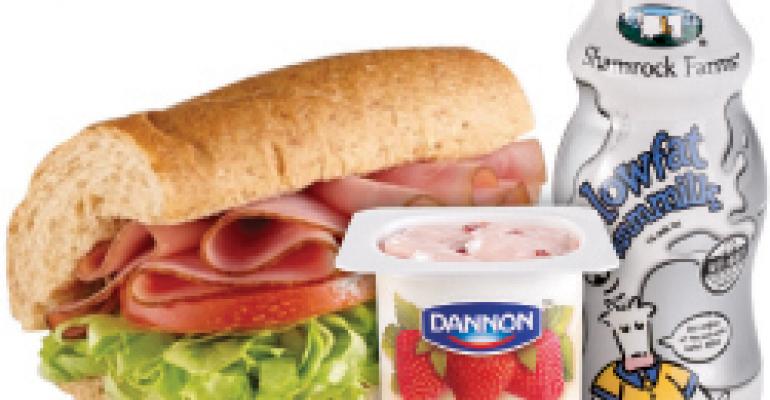With products like Fresh Apple Fries, low-fat milk and macaroni and cheese, Burger King Corp. is capitalizing on the trend towards healthier eating for children.
The Miami-based chain recently reported that just five weeks after launching Fresh Apple Fries, a nonfried lookalike item served in paper French fry sleeves, more than 3 million portions of the Red Delicious shoestrings had moved as kids’ meal items, exceeding BK’s expectations by 85 percent. That result apparently included an unspecified quantity of à la carte sales at about $1.49 each.
But while the No. 2 burger chain has been upbeat about consumer response to the fresh-fruit item, only a handful of other food-service operators appear to be pursuing new diet-oriented marketing tactics beyond those adopted in recent years in the face of mounting concerns about childhood obesity and early-onset diabetes.
The Center for Science in the Public Interest, the watchdog group in Washington, D.C., recently published a report assailing many quick-service chains, saying they have a long way to go toward offering healthy options for children.
The CSPI claimed that 93 percent of 1,474 possible choices at 13 chains exceed 430 calories. That represents one-third of what the Washington, D.C.-based Institute of Medicine recommends that children ages 4 through 8 should consume in a day, the report said.
Nevertheless, some operators contend that while they do not market directly to children, they do indeed offer more health-oriented kids’ choices. An official of Richmond Heights, Mo.-based Panera Bread, for example, said its “well-received” kids’ meal does have a healthy flair, including sandwiches with organic ingredients on whole-grain bread accompanied by organic yogurt.
Not all quick-service chains were faulted by the CSPI. It praised the Subway chain for its Fresh Fit for Kids meals, two-thirds of which don’t exceed the 430-calorie threshold, and for not bundling soft drinks with the meals. Subway spokesman Les Winograd pointed out that the chain five years ago swapped a cookie for a healthier snack in its kids’ meals. Two years ago Subway rolled out the California Fit Kids’ Pak, with a low-fat sandwich, such “fit” sides as sliced apples and raisins, and low-fat milk.
Subway’s program, which was rolled out systemwide last year, stemmed from a collaboration with California Gov. Arnold Schwarzenegger and his push to establish health and fitness initiatives in the state. The Fresh Fit for Kids meals include yogurt and juice options and toy premiums promoting physical activities.
McDonald’s also has chosen to market more health-oriented selections to children. The Oak Brook, Ill.-based chain is one of 10 founding members of the two year-old Children’s Food and Beverage Advertising Initiative, whose members include Burger King and leading packaged-food makers.
McDonald’s had launched the Happy Meal Choice program as long ago as 2004, adding such options Apple Dippers and milk as a kids’ meals beverage. The chain’s kids’ meals now offer either a 4-piece Chicken McNuggets Happy Meal with Apple Dippers, a low-fat caramel dip and a 236-milliliter “jug” of 1-percent-fat milk, or the Hamburger Happy Meal, with Apple Dippers, the caramel dip and the low-fat milk. This year the QSR segment leader added to its kids’ menu a grilled Snack Wrap option that comes with a Fruit n’ Yogurt Parfait with granola and a 16.9-ounce bottle of water.
In late June, Burger King rolled out its health-oriented kids’ meal to all U.S. branches of the chain. The meal, which features the Fresh Apple Fries with caramel dipping sauce, macaroni and cheese and 1-percent-fat milk, contains 350 calories and 9.5 grams of fat. The Apple Fries are just 25 calories if eaten alone.
Mike Fletcher, Burger King’s senior manager for global youth and family marketing, said the kids’ meal change was made “because children are an important focus of our marketing efforts” and BK “felt like we could do a great deal of good in focusing our efforts toward nutritious meals.”
Last September the chain joined the Better Business Bureau’s Children’s Food and Beverage Advertising Initiative to modify its advertising to children under 12 and promote healthy dietary choices. As part of that commitment, Burger King developed a set of nutritional guidelines for the kids’ meals it advertises. By December, the company said, it would only advertise kids’ meals that provide no more than 560 calories, fewer than 30 percent of their calories from fat, fewer than 10 percent of calories from saturated fat and no added trans fats.
The Fresh Apple Fries are a natural extension of what kids already enjoy, Fletcher said.
“This is the marriage of a familiar food product with R&D innovation. We take a plain old apple cut up, and tap into all the things consumers and kids like about French fries: They are delicious, portable finger foods that are dippable, and the caramel packet resembles a ketchup packet,” he said. “We felt that kids would enjoy something that was very familiar to them that is also healthy.”
Fletcher said the Fresh Apple Fries had won the Kid Friendly Product of the Year honor from the Glycemic Research Institute in Washington, D.C., and he added that BK is now developing other healthy kids’ menu items.

